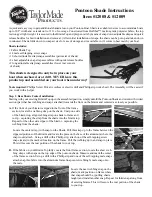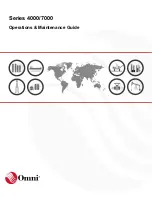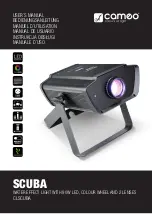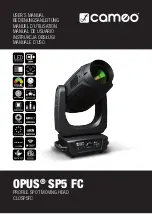
Companion Portable Technical Service Manual •
PN 20562220 Rev B
18
Companion P
or
tables
Operation
IX
i. When you notice a change in the sound of the venting gas,
followed by the emission of a dense, white vapor around the
reservoir shroud, close the vent valve to terminate the fill.
j. Disengage the C1000/T from the reservoir by holding the
carrying strap above the unit and pressing the release button
on the reservoir. Should the units not disengage easily, they
may be frozen together. Do not use force. Allow a few mo-
ments for the frozen parts to warm. Disengage the units after
the ice has melted.
k. Check the liquid oxygen contents indicator to verify that the
C1000/T is full of liquid oxygen.
Liquid Level Measurement
1. Suspend the C1000/T by the strap nearest the liquid level
gauge.
2. Observe the location of the needle on the liquid level gauge.
3. The green section of the color coded gauge indicates a full
unit.
Filling
1. Fill Source Preparation
a. Ensure that the liquid reservoir contains a sufficient amount
of liquid oxygen to completely fill the portable.
b. Ensure the liquid oxygen in the fill source is properly satu-
rated according to its technical manual filling instructions.
2. Fill Procedure
a. Companion T Only: Remove the moisture cup from the bot-
tom of the unit
b. Using a clean, dry, lint-free cloth, dry the male QDV on the
reservoir and the female QDV on the C1000/T.
c. Hold the C1000/T with both hands and position its female
QDV over the male QDV of the reservoir.
d. Lower the C1000/T carefully into place, ensuring the fill
connectors are properly aligned.
e. Place one hand on top of the C1000/T and press straight
down. This will lower the unit about 3/8 in, properly engag-
ing the fill connectors.
f. While holding the C1000/T in this position, move the vent
lever to the open position. A hissing sound will be heard in-
dicating liquid flowing into the portable.
g. During the filling operation, maintain a slight downward
pressure on the C1000/T with one hand to ensure stability
and proper filling position.
h. Approximately 20-30 seconds into the fill, close and reopen
the vent valve one or more times to prevent the vent valve
from freezing open.
WARNING:
Fill source must be in a well ventilated area to pre-
vent development of an oxygen enriched atmosphere.
NOTE: Reference section VII for information on the effects of an
improperly saturated reservoir on the C1000/T
CAUTION: Do not leave the Companion 1000/T unattended
during the filling operation. Excessive liquid oxygen discharge
can occur
CAUTION: Do not depress or disturb the plastic poppet in the
center of the reservoir fill connector. This will cause an uncon-
trolled release of liquid oxygen from the fill connector.
CAUTION: Liquid oxygen discharge from the fill connector can
occur. When disconnecting the Companion 1000/T, never stand
directly over the reservoir QDV. If the reservoir QDV stays open
and minor liquid oxygen discharge occurs, carefully re-engage
and disengage the Companion 1000/T to help dislodge any ice
or other obstruction. If major liquid oxygen discharge (steady
stream) occurs, open the reservoir vent valve (if safely possible)
to vent pressure and stop the release of liquid oxygen. Open
windows and doors to ventilate the room. Do not walk on areas
exposed to liquid oxygen for 60 minutes after frost disappears.
CAUTION: If the vent valve fails to close and the hissing contin-
ues, remove the Companion 1000/T by pressing the release but-
ton on the stationary. Keep the Companion 1000/T in an upright
position. The unit will stop venting in a few minutes. Allow the
unit to warm until you can close the vent valve. It may require
as much as two to three hours with the flow control off for the
Companion 1000/T to restore adequate pressure for accurate
oxygen delivery.
NOTE: The pressure in the Companion 1000/T may be slightly
lower than normal for up to 20 minutes after filling the unit. This
may cause actual oxygen flows to be slightly lower than normal.
WARNING:
The fill connectors must be clean and dry before
filling the C1000/T. Moisture on the fill connectors can lead to
leakage of liquid oxygen. Moisture can also cause the units to
freeze together, and can lead to malfunctions of the portable or
reservoir.
















































